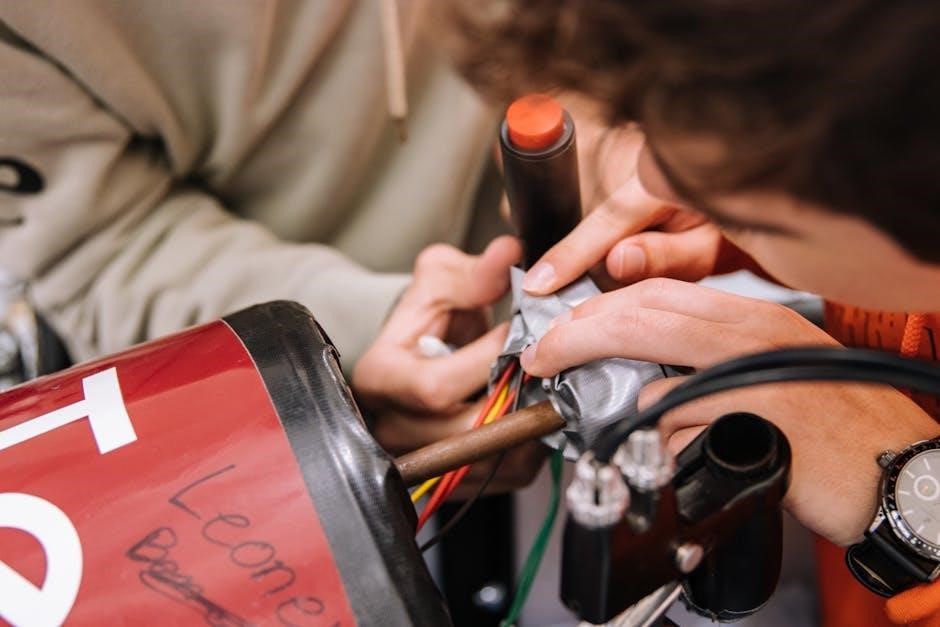american farmworks electric fence manual
American Farmworks electric fences provide reliable livestock control and property protection․ This manual guides users through understanding, installing, and maintaining their electric fence systems effectively․
1․1 Overview of American Farmworks Electric Fence Systems
American Farmworks electric fence systems are designed for durable and efficient livestock management․ They offer a range of components, including chargers, wires, posts, and accessories, tailored to various farming needs․ These systems are known for their reliability in deterring predators and keeping animals contained․ With customizable options, farmers can adapt the fencing to suit different terrains and weather conditions․ The systems prioritize safety, with features like low impedance and high voltage output, ensuring effective animal control without causing harm․ American Farmworks electric fences are a popular choice for their ease of installation, maintenance, and long-term performance in agricultural settings․
1․2 Importance of Electric Fencing in Agriculture
Electric fencing plays a crucial role in modern agriculture by providing effective livestock management and property protection․ It ensures animals remain within designated areas while keeping predators out, safeguarding both livestock and crops․ Electric fences are cost-effective and require minimal maintenance compared to traditional fencing methods․ They also offer flexibility, allowing farmers to easily adjust or expand their fencing as needed․ By preventing unauthorized access and reducing the risk of animal escape, electric fencing helps farmers maintain productivity and security․ Its efficiency and durability make it an essential tool for sustainable and profitable agricultural operations in diverse environments and conditions․

Understanding the Components of the Electric Fence
Understanding the components of an electric fence is essential for proper installation and functionality․ Key elements include the charger, wires, posts, insulators, and grounding rods, each serving critical roles․
2․1 Key Components of the Electric Fence System
The electric fence system consists of several essential components․ The charger, or energizer, is the power source that generates the electric pulse․ Wires or conductors carry the charge, while posts provide structural support․ Insulators prevent energy loss by keeping the wire isolated from the posts․ Grounding rods complete the circuit, ensuring the pulse is effective․ These components work together to create a secure and efficient fencing system tailored for livestock control and property protection․
2․2 The Role of the Charger, Wires, and Posts
The charger, or energizer, is the core of the electric fence system, generating a high-voltage pulse to deter animals and intruders․ Wires, such as high-tensile or poly wire, carry this charge, creating a continuous electrical circuit․ Posts, whether wooden, metal, or plastic, provide structural support, holding the wires at the correct height and spacing; Together, these components ensure the fence operates effectively, balancing durability and safety to manage livestock and protect property․
2․3 Understanding Grounding and Insulation
Proper grounding is essential for the electric fence to function safely and effectively․ Grounding completes the electrical circuit, allowing the pulse to return to the charger․ Multiple ground rods are typically required, especially in dry soil, to ensure a strong connection․ Insulation, such as plastic or ceramic insulators, prevents electrical current from being lost to metal posts or other conductive materials․ Proper insulation ensures the charge travels along the fence wires, maximizing efficiency․ Grounding and insulation work together to ensure the system operates safely, preventing energy loss and potential hazards while maintaining effective livestock control․

Safety Precautions and Best Practices
Always handle live wires with caution, wear insulated gloves, and avoid contact with metal objects․ Turn off the charger before working on the fence․ Never touch the fence and another conductive object simultaneously․ Regularly inspect wires and insulators to prevent hazards․ Ensure all safety protocols are followed to protect humans, animals, and property while maintaining an effective electric fencing system․
3․1 General Safety Guidelines for Handling Electric Fences
Always prioritize safety when working with electric fences․ Turn off the charger before performing any maintenance or repairs․ Use insulated gloves to handle live wires, and avoid contact with metal objects․ Be cautious in wet conditions, as moisture increases conductivity․ Never touch the fence with both hands or while leaning on metal objects․ Keep children and pets away from the fence․ Regularly inspect wires and insulators for damage․ Use appropriate tools for repairs to avoid accidental shocks․ Always stay alert and follow manufacturer guidelines to ensure safe handling of electric fence components․
3․2 Safety Tips for Humans and Animals
Always ensure humans and animals are aware of the electric fence’s presence․ Avoid touching the fence with bare hands or metal objects․ Keep loose clothing and jewelry away from wires․ Train animals gradually to avoid shocking them unnecessarily․ Provide clear warning signs for visitors․ Never allow children to play near the fence․ Ensure animals are introduced to the fence safely to prevent stress․ Regularly inspect the fence for damage to avoid accidental shocks․ Keep emergency shut-offs accessible in case of an accident․ Always prioritize the well-being of both humans and animals when working with or near electric fences․
Planning and Designing the Electric Fence
Planning and designing an electric fence involves assessing property needs, understanding terrain, and creating a layout that ensures effective containment and safety for animals and humans․
4․1 Assessing Your Property and Fencing Needs
Evaluating your property and fencing needs is crucial for an effective electric fence system․ Start by assessing the terrain, identifying obstacles, and determining the purpose of the fence․ Consider the size of the area, the type of animals being contained, and potential threats like predators․ Measure the perimeter and note any slopes or uneven ground that may affect installation․ Decide whether the fence will be permanent or temporary and choose materials accordingly․ Budget considerations and local regulations should also be factored in․ A clear understanding of your requirements ensures a well-designed and functional electric fencing system․ Proper planning prevents costly mistakes․
4․2 Creating a Layout and Design Plan
Developing a detailed layout and design plan is essential for a successful electric fence installation․ Start by sketching the fence line on paper, marking gate locations, corners, and areas where components like chargers and grounding rods will be placed․ Consider the spacing of posts, wire spacing, and the number of strands needed based on the type of animals and terrain․ Use a scale map to measure distances accurately․ Identify potential challenges, such as uneven ground or water sources, and plan accordingly․ A well-thought-out design ensures proper functionality, efficiency, and longevity of the electric fence system․ Adaptability should also be considered for future changes․

Installation Guide for the Electric Fence
Installing an American Farmworks electric fence involves setting posts, stretching wires, and connecting the charger․ Ensure proper spacing, grounding, and insulation for optimal performance and safety․
5․1 Step-by-Step Instructions for Assembling the Fence
Begin by planning the fence layout based on your property’s dimensions and needs․ Mark the corners and gate locations․ Dig holes for the posts, ensuring they are spaced evenly․ Insert the posts into the ground, securing them with concrete or dirt․ Next, attach insulators to the posts to hold the electric wires․ Stretch the wires tightly between the posts, avoiding sagging․ Connect the wires to the charger and ensure proper insulation․ Finally, test the system to confirm it is functioning correctly․ Follow the manufacturer’s instructions for specific details and safety precautions during assembly․
5․2 Proper Grounding Techniques
Proper grounding is essential for the electric fence to function effectively․ Start by selecting a suitable location for the ground rod, ensuring good soil conductivity․ Drive a galvanized ground rod at least 3 feet into the earth․ Connect the ground wire to the rod using a high-quality ground clamp․ Ensure the wire is free from corrosion and tightly secured․ For larger systems, multiple ground rods spaced 10-20 feet apart may be necessary․ Avoid grounding near metal objects or structures to prevent interference․ Regularly inspect the grounding system to ensure optimal performance and safety․ Proper grounding ensures the fence delivers a consistent and effective shock․
5․3 Connecting the Charger and Testing the System
To connect the charger, first ensure all components are properly installed and grounded․ Attach the positive wire from the charger to the fence wire and the negative wire to the ground system․ Turn on the charger and use a voltage tester to check the fence line․ Ensure the voltage reading meets the recommended level for your specific needs․ Test multiple points along the fence to confirm consistent power distribution․ Address any low voltage areas by inspecting connections or adding additional ground rods if necessary․ Always follow safety precautions when testing to avoid electric shock․ Proper testing ensures the system operates effectively and safely․

Maintenance and Repair of the Electric Fence
Regular inspections and timely repairs are essential to ensure the electric fence functions effectively․ Check for damage, wear, and proper voltage to maintain system performance and longevity․
6․1 Regular Maintenance Checks
Regular maintenance is crucial for ensuring the electric fence operates efficiently․ Start by inspecting the wires, posts, and insulators for damage or wear․ Use a voltage tester to check the fence’s power output․ Clean insulators and posts to prevent moisture buildup; Inspect the charger and grounding system for proper function․ Check for vegetation growth near the fence, as it can reduce effectiveness․ Replace any damaged or corroded components promptly․ Keep a record of maintenance activities to track the system’s condition․ Regular checks help prevent issues before they escalate, ensuring the fence remains reliable for livestock control and property protection․
6․2 Troubleshooting Common Issues
Common issues with electric fences include low voltage, faulty chargers, and poor grounding․ Start by testing the voltage with an electric fence tester․ If voltage is low, check for broken wires, loose connections, or excessive vegetation touching the fence․ Inspect the charger for damage or malfunction and ensure it is properly connected․ Verify grounding by checking that ground rods are correctly installed and free from corrosion․ Address any issues promptly to restore the fence’s effectiveness․ Regular troubleshooting ensures the system functions optimally, preventing livestock escape or predator entry․ Always refer to the manual for specific solutions tailored to your American Farmworks system․
6․3 Repairing Damaged Components
Repairing damaged components of your American Farmworks electric fence is essential for maintaining its effectiveness․ Start by turning off the charger to ensure safety․ Inspect the fence for broken wires, damaged insulators, or worn-out posts․ Replace broken wires with high-quality alternatives, securing them tightly to posts․ Damaged insulators should be swapped with new ones to prevent electrical short circuits․ For broken posts, dig out the old one and install a new post, ensuring it is firmly anchored․ After repairs, turn the charger back on and test the system to confirm proper operation․ Regular inspections and timely repairs prevent further damage and ensure long-term reliability․

Optimizing the Performance of the Electric Fence
Optimizing your American Farmworks electric fence ensures maximum efficiency and effectiveness․ Regular maintenance, proper grounding, and adjusting settings enhance performance, providing reliable livestock control and property security․

7․1 Ensuring Maximum Efficiency
To ensure maximum efficiency, regular inspections are crucial․ Check for proper grounding, insulation, and voltage levels․ Vegetation should be kept clear to prevent energy loss․ Use high-quality components and avoid overloading the system․ Regularly test voltage with a tester and adjust settings as needed․ Keep the fence lines free from damage or wear․ Proper spacing of posts and wires ensures even energy distribution․ Weather conditions can impact performance, so seasonal adjustments may be necessary․ Monitoring the system regularly helps identify and address issues promptly, ensuring optimal functionality and longevity of the electric fence․
7․2 Adjusting Settings for Different Weather Conditions
Weather conditions can significantly impact the performance of your electric fence․ In dry conditions, increase voltage settings to compensate for higher resistance․ In wet or rainy weather, reduce voltage to prevent energy loss․ Snow and ice require careful adjustment to maintain effectiveness without overloading the system․ Regularly monitor voltage levels using a tester and adjust the charger output accordingly․ Ensure proper grounding in moist soil and check insulation integrity during cold snaps․ Seasonal adjustments help maintain consistent performance․ Keep vegetation trimmed year-round to avoid interference․ By adapting settings to weather changes, you can ensure the fence remains efficient and reliable in all conditions․

Common Mistakes to Avoid
Common mistakes include improper grounding, overloading the system, and neglecting regular maintenance․ Ensure proper installation and routine checks to maintain safety․
8․1 Avoiding Poor Installation Practices

Proper installation is crucial for the effectiveness and safety of your electric fence․ Common mistakes include incorrect post spacing, inadequate grounding, and poor wire tension․ Always follow the manual’s guidelines for post placement and wire alignment․ Ensure grounding rods are installed correctly to prevent voltage drops․ Avoid overloading the system with too many wires or components․ Poor insulation and loose connections can lead to energy loss and safety hazards; Regularly inspect and tighten all connections․ Use high-quality materials to withstand weather conditions․ Properly test the system before use to ensure it operates safely and efficiently․ Correct installation ensures long-term reliability and safety․
8․2 Mistakes in Grounding and Insulation
One of the most critical errors in electric fencing is improper grounding and insulation․ Inadequate grounding can prevent the fence from functioning correctly, as it relies on a complete circuit․ Using too few ground rods or placing them in dry soil reduces system efficiency․ Poor insulation, such as using low-quality materials or exposing wires to moisture, can lead to energy loss and safety hazards․ Insulation failures can also cause short circuits, reducing the fence’s effectiveness․ Always use high-quality insulators and ensure proper grounding techniques․ Regularly inspect insulation for damage or wear․ Correcting these issues ensures optimal performance and long-term reliability of the electric fence system․

American Farmworks Electric Fence systems offer reliable and efficient solutions for livestock control and property protection․ Follow the manual’s guidelines to ensure safety, performance, and longevity of your fencing system․
9․1 Summary of Key Points
American Farmworks Electric Fence systems are effective for livestock control and property protection․ Proper installation, regular maintenance, and adherence to safety guidelines ensure optimal performance and longevity․ Key components like chargers, wires, and posts must be correctly installed and maintained․ Grounding and insulation are critical for system efficiency․ Always follow safety precautions to protect humans and animals․ Planning and designing the fence according to property needs ensures functionality․ Troubleshooting and repairing issues promptly prevents system failures․ By following the manual’s instructions, users can maximize the effectiveness and reliability of their electric fencing system for years to come․
9․2 Final Tips for Effective Electric Fencing
Regularly inspect and maintain your electric fence to ensure optimal performance․ Test voltage levels to confirm the system is functioning correctly․ Keep fencing clear of debris to maintain proper grounding․ Use high-quality components to avoid premature wear and tear․ Always follow the manufacturer’s instructions for installation and maintenance․ Adjust settings seasonally to account for weather changes that may impact efficiency․ Be mindful of power outages and have a backup plan for critical fencing needs․ Consult professionals for complex installations or repairs․ By following these tips, you can ensure your American Farmworks electric fence remains reliable and effective for years to come․

